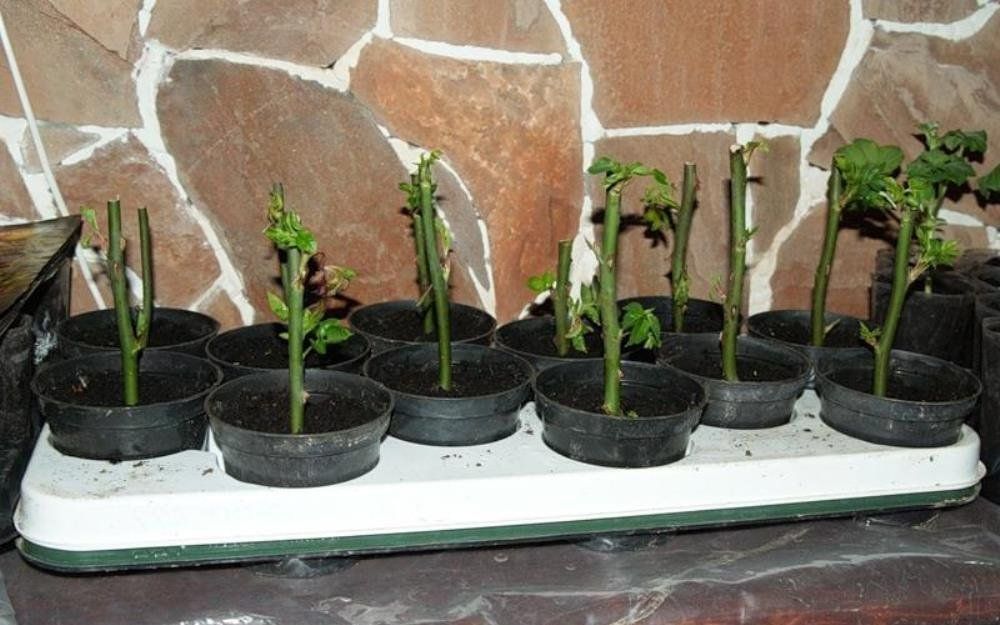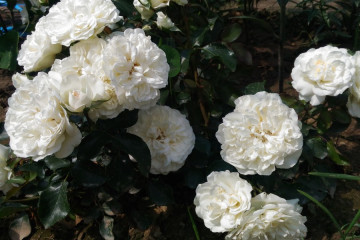Rose Maria Theresia (Maria Theresia) - description of the culture
Content:
In every garden there should be a main element to which one would like to approach and take a closer look, inhale the aroma of delicate flowers. The rose Maria Theresia may well become such an element. It is very beautiful in group plantings, combined with cereals, gives a gentle and sensual accent to a garden or summer cottage.
Description of the variety
Maria Theresia rose is an abundantly flowering shrub also called Floribunda. The variety was bred in Germany as a result of crossing polyanthus roses with hybrid tea relatively recently.
Roses of this variety grow no higher than 80 cm in height, the bush grows 50 cm wide. Flowers open in a bowl. The buds are divided into four parts and resemble peony inflorescences. They open gradually and have a delicate pearl pink color, located three to five per inflorescence. They are contrasted with the rich green color of the leaves. The bush is suitable for cutting bouquets, looks smart and elegant.
The advantages of this variety are continuous and long flowering, immunity to various fungal diseases, frost resistance and excellent rain tolerance.
Also, the variety has disadvantages:
- long period of bud shedding - up to 10 days;
- tendency to overgrowth - some bushes can reach 100 cm;
- deformed branches often grow.
Despite the shortcomings, this variety is loved by many gardeners.
Landing
Rose Maria Theresa is planted in spring and only with seedlings. They should be planted in March-April, when the ground begins to warm up. In frozen soil, the root system will not take root, and there is a possibility of the death of the shrub.
Site selection and soil preparation
In order to choose a place for planting this variety, you just need to look out of the window and determine where it will look best. This variety of roses should be pleasing to the eye. It is suitable for landscaping a summer cottage or personal plot. A well-groomed hedge of shrubs looks ideal. It is also suitable for the central figure in the flowerbed, for the rock garden.
The place should be sufficiently lit, high without stagnant groundwater. The place should be well ventilated, but drafts should not be allowed. The soil for Maria Theresa can be neutral or slightly acidic.
Planting process
Before planting, you need to soak the roots in a solution of water and clay for ten minutes. First, a hole is dug, about 60 cm deep and slightly larger than the rhizome. Such dimensions are necessary so that the root system is spaciously located in the ground.
Drainage is laid at the bottom of the hole - pebbles, gravel, brick fragments. Next, fertilizer or rotted manure is poured. Then a seedling is installed in the hole, the roots are straightened and carefully covered with earth. The root collar should be 3 cm below ground level.
Rose care
Floribunda Maria Theresia rose is not difficult to care for. The shrub loves moisture and should be watered every week.
Top dressing
Immediately after the rose is planted, you need to carry out the first fertilizing with nitrogen fertilizer. The second time it is fed when buds appear, potash fertilizers are applied, and just before flowering - superphosphate.
Pruning
Pruning is a must for this rose variety. It allows you to form a neat bush and lays the next flowering. Removal of excess shoots must be carried out in the spring, before the buds wake up. Summer pruning involves cutting off faded buds, since it takes a lot of energy to ripen the fruit.
In the fall, it is necessary to inspect the rose bush, remove strongly overgrown branches, remove shoots with signs of fungal diseases. You can also rejuvenate the rose bush by pruning. To do this, leave 2-4 buds from the ground on the branches. For early flowering, you need to carry out a moderate removal of 5-7 buds from the base.
In the first year, you need to remove all the buds that tie on the bush, with the exception of three pieces. Leaving one or two buds left, letting them bloom and waiting for the fruit will stimulate Teresa to set buds profusely and bloom profusely. The buds are removed before early August.
Wintering
Roses should be covered for the winter after -7 ° C. It is believed that up to this temperature, roses can easily tolerate the cold without shelter. Before you cover the rose, you need to mulch it. Covering with earth is suitable, you can also spud and close with spruce branches. The entire structure should be 20 centimeters higher than the bush itself. The shelter is fixed with wire, or any convenient material.
Bloom
In the encyclopedia, the Floribunda Maria Teresa rose is described as a highly branched shrub with continuous flowering. It starts in June and ends in October. Throughout the summer, buds appear on it. The bush is covered with inflorescences of 5-9 flowers and becomes completely pink. According to gardeners' descriptions, the Mariatheresia rose blooms in the same style as the Topala rose.
Delicate rose buds create a pleasant contrast to the emerald foliage. When the rose reaches its peak flowering, it becomes the main element and the key figure of the summer cottage for a long time. The shrub attracts attention and enchants with a light pleasant aroma.
Why does not it bloom and what to do
If the bush does not bloom, then several reasons can be considered:
- growing shrubs nearby;
- improper nutrition;
- erroneous irrigation system.
One of the reasons is the inconvenient neighborhood. It happens that plants begin to oppress each other if planted too close. Therefore, before planting, it is necessary to take into account and calculate the growth of nearby shrubs and trees.
Reproduction
Rose Floribunda Maria Theresia propagates in the traditional way - by cuttings. It can be done in spring, summer and even fall. Green shoots are chosen for cuttings. The stem thickness should not be more than 5 mm, the height - 15 cm. The cut is made at an angle of 45 ° and immersed in a stimulating solution. These can be various drugs, for example, "Kornevin".
At least 3 buds should remain on the cuttings. Cuttings are planted in the ground and greenhouses are arranged. Planting depth is about 3 cm. Further, care for the cuttings is normal - periodic airing and watering. After a month, they begin to harden and, over time, the greenhouses are removed.
Diseases and ways to deal with them
This variety is resistant to many diseases, however, it is worthwhile to periodically carry out prevention. It is worth spraying the bush from microbes and fungi with fungicides at least three times per season. Prevention of many diseases - harvesting fallen leaves, pruning dry and old shoots.
Bordeaux liquid or copper sulfate will help against fungal infections. You can also use organic methods - infusion of garlic, onion, tobacco. If, nevertheless, the disease has begun, then three times treatment with fungicides with a two-week break will help.
In order to decorate a garden or summer cottage and to settle a “queen of flowers” on a flower garden, just one moment is enough - desire.If it is available, then even an inexperienced gardener will be able to organize a gorgeous flower garden on the territory of the garden, which will be crowned with a beautiful rose.



















